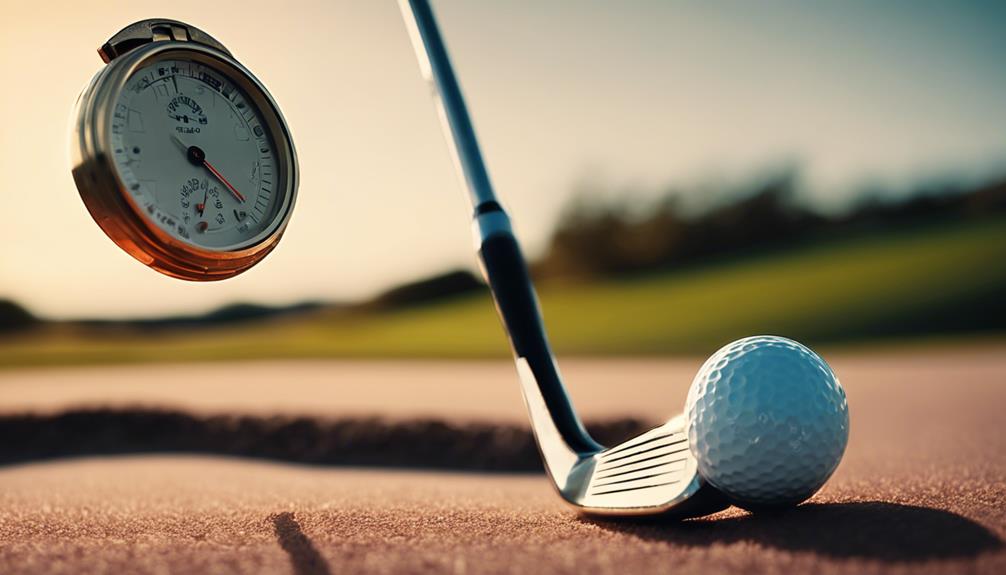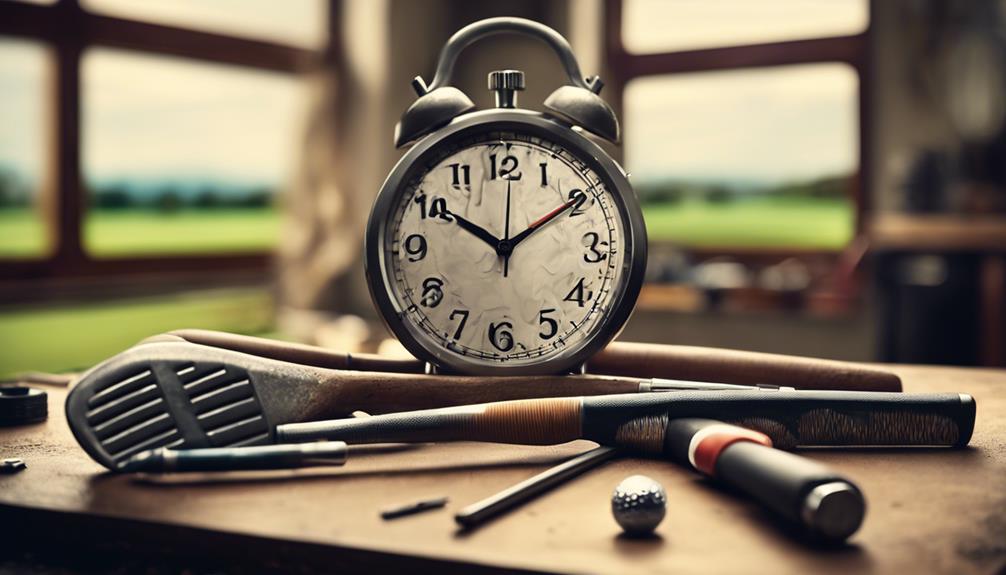- 7 Top Flite Golf Clubs XL for Improved Performance - September 28, 2024
- Top Flite Golf Clubs: Top 5 Reasons to Choose Them - September 28, 2024
- Top 3 Golf Club Fitters for a Perfect Swing - September 28, 2024
You can safely use your regripped golf club after allowing it to dry for a minimum of 6 hours, ensuring a strong bond between the grip and the shaft. This waiting period is important, as it prevents grip slippage during play. Rushing to use your club can lead to issues with the grip's adhesion, compromising your game. By waiting, you'll get a secure hold and best performance. Now that you know the minimum drying time, you're likely curious about the regripping process and expert tips to get the most out of your clubs.
Key Takeaways
- Wait a minimum of 6 hours after regripping before using your golf club to ensure a strong grip bond.
- Overnight drying is recommended for optimal grip adhesion and long-term performance.
- Rushing to use regripped clubs can result in grip slippage and poor performance during play.
- Natural air drying is preferred, but gentle air flow from a compressor can speed up the drying process.
- Prioritize a secure hold over a quick return to the course, as proper drying time is essential for grip durability.
Regripping Challenges and Solutions
When regripping your golf club, you'll likely encounter a few challenges that can make the process frustrating and time-consuming. One of the most significant hurdles is removing the old grip and tape efficiently. This is where having the right tools comes in handy.
Using a hook blade and a vice can make the removal process safe and organized. The hook blade helps to cut through the old grip and tape, while the vice holds the club securely in place, allowing you to apply even pressure. By using these tools, you'll be able to remove the old grip and tape quickly and easily, without damaging the club.
Additionally, make sure to clean the surface thoroughly before applying the new grip, as any residue can affect the adhesion. By overcoming these challenges, you'll be able to achieve a successful regripping process that will improve your game.
Grip Installation Techniques and Tips
With your previous grip removed and the surface cleaned, it's time to focus on installing your new grip, and there are several techniques and tips to keep in mind to ensure a successful installation.
When selecting a grip, consider the type of shaft you have, as multi-material grips work well with air installation, while ribbed grips may be preferred for ease and perfection. Build-up tape is commonly used, especially for jumbo sizes or thicker sides preferred by those with larger hands. You can also use air for grip installation, but be cautious with wrap-style grips to avoid damage.
For popular grip choices like Lamkin Crossline and Avon Chamois, it's recommended to leave them overnight to dry for best adhesion. Remove any old tape and clean the surface before applying the new grip. Remember to follow the manufacturer's instructions for drying times, which can vary depending on solvents used and weather conditions.
Aim to wait at least 4 hours or overnight before playing for the best grip security.
Effects of Heat on Golf Clubs

When regripping your golf clubs, it's crucial to take into account the effects of heat on your equipment.
You might be wondering if leaving your clubs in a hot car trunk will cause the epoxy to melt or loosen, but you'll be relieved to know that the epoxy's high melting point makes it more durable than you expect.
As you examine the impact of heat on your golf clubs, you'll also want to keep in mind the dangers of leaving your clubs unattended, especially in warm weather.
Epoxy Melting Point
Exposing your golf clubs to high temperatures raises concerns about the epoxy's melting point, a critical component in golf club assembly that boasts an impressive 250°F tolerance.
You might be worried that leaving your clubs in a hot car trunk could compromise the epoxy, but rest assured that it's highly unlikely. The epoxy's high melting point means it can withstand temperatures that are typically not reached in a car trunk.
In fact, urban myths about epoxy melting in hot conditions aren't supported by its high melting point. Many golfers have left their clubs in trunks without experiencing any epoxy-related issues, further solidifying its stability.
When you compare the epoxy's melting point to car trunk temperatures, it's clear that there's no risk of melting during storage. This means you don't have to worry about the epoxy compromising your grip solvent or the overall integrity of your club.
You can confidently store your clubs, even in warm conditions, without worrying about the epoxy's melting point.
Leaving Clubs Unattended
You've likely wondered what happens to your golf clubs when you leave them unattended in a hot car trunk, especially considering the potential effects of heat on the club's overall performance.
One major concern is the epoxy used to bond the grip to the butt end of the club. However, it's reassuring to know that epoxy has a high melting point, making it less susceptible to heat damage.
While urban myths suggest that epoxy can come loose in hot conditions, these claims aren't fully substantiated. In reality, many golfers have reported leaving their clubs unattended in trunks without experiencing any issues.
To better understand the risks, it's helpful to compare the melting point of epoxy to car trunk temperatures. By doing so, you can gain a clearer understanding of the potential effects of heat on your golf clubs.
Theft Concerns
Leaving your golf clubs unattended in a hot car trunk also raises concerns about theft, a risk that's often overlooked in favor of worrying about heat damage. While you're busy thinking about the potential effects of heat on your clubs, thieves might be eyeing your expensive golf gear.
As you weigh the risks of heat exposure, don't forget to take into account the possibility of theft.
Here are some key points to keep in mind:
- Theft is a real risk: Leaving your clubs in a hot car trunk can make them an attractive target for thieves.
- Heat damage is often exaggerated: Urban myths about epoxy coming loose in hot conditions are just that – myths.
- Epoxy has a high melting point: It's unlikely to be affected by the temperatures found in a car trunk.
- Personal experiences vary: Some golfers have left their clubs in trunks without issues, while others have had problems.
Drying Time and Techniques After Regripping
Now that you've successfully regripped your golf club, focusing on the drying time and techniques is crucial to achieve a durable and long-lasting grip.
You'll want to explore various drying methods, considering their advantages and disadvantages, to determine the most suitable one for you.
Drying Methods Compared
When regripping your golf club, the drying time and technique you choose can greatly impact the performance and longevity of the new grip. You've invested time and effort into getting the perfect wrap style, and now it's essential to let it dry properly.
You have a few options to expedite the drying process.
Here are some drying methods compared:
- Natural air drying: This is the most recommended method, allowing the solvent to evaporate naturally. It may take longer, but it's the safest bet.
- Blowing on the grip: A gentle blow can help speed up the process, but be cautious not to blow too forcefully, which can create air pockets.
- Using a compressor: This method can greatly reduce drying time, but make sure to follow the manufacturer's instructions to avoid damaging the grip.
- Waiting overnight: If you're not in a hurry, letting the grip dry overnight can guarantee a strong bond between the grip and shaft.
Solvent Drying Times
After regripping your golf club with solvent, you should allow at least 6 hours of drying time to make sure the grip adheres properly to the shaft. This waiting period is pivotal, as it allows the solvent to cure fully, preventing grip slippage during play.
Make sure to keep your clubs in a dry and cool area during the curing process to achieve best results. Rushing to use your regripped clubs before the solvent has fully dried can compromise grip performance, leading to subpar game outcomes.
To achieve the best grip installation outcome, it's vital to follow the manufacturer's instructions for drying times. Don't take shortcuts, as this can void the warranty or lead to premature grip wear.
Overnight Vs Immediate
You'll get the best results by adopting an overnight drying method, which allows the solvent to form a rock-solid connection with the shaft, guaranteeing a secure hold that won't slip or fail during play. This method allows the solvent to fully dry and harden, creating a long-lasting connection that will withstand the demands of your golf game.
If you're excited to get back on the course, you may be tempted to use your regripped clubs immediately. However, this can lead to grip slippage or inadequate adhesion, which can negatively impact your game.
Here are some key takeaways to keep in mind:
- Wait at least 6 hours before playing with your regripped clubs to make sure the solvent has had time to dry.
- Avoid hurrying to use your clubs, as this can lead to grip issues during play.
- Choose overnight drying for optimal grip adhesion and a secure bond.
- Prioritize a secure hold over getting back on the course quickly, as it will pay off in the long run.
Community Conversations on Regripping

Discussions within the golf community highlight the importance of allowing sufficient drying time after regripping, with members sharing varied experiences and advice on achieving best grip adhesion.
You'll find that many golfers recommend waiting at least 6 hours before using your clubs after regripping, but some suggest overnight drying to ensure proper adhesion of the grip. The layers of tape applied during the regripping process need time to bond correctly, and rushing this step can lead to grip slippage during play.
Experienced golfers and professionals often provide valuable insights into the regripping process, including drying times. By consulting with them, you can gain a better understanding of the optimal drying time for your specific grip type and environmental conditions.
Preferred Grip Types and Installation Methods
When choosing a grip type, golfers often prioritize durability and feel, with popular options like Lamkin Crossline and Avon Chamois offering a winning combination of both. As you consider regripping your clubs today, remember to think about your personal preferences and playing style.
Here are some key factors to keep in mind:
- Hand size matters: If you have larger hands, you may prefer jumbo grips with thicker sides for better control.
- Installation methods vary: While air installation is common, some golfers prefer ribbed grips for ease and precision.
- Adjusting grip size: Multiple layers of build-up tape can be used during installation to achieve the perfect fit.
- Personal experiences differ: What works for someone else may not work for you, so it's important to experiment and find the grip type and installation method that suits your game.
Frequently Asked Questions
How Long After Regripping a Club Can You Use It?
After completing the regripping process, you'll need to wait at least 6 hours before using your club to guarantee the solvent cures properly, allowing for best grip adhesion and preventing slippage during play.
How Can I Make My Golf Grips Dry Faster?
You can accelerate grip drying by employing efficient drying techniques, such as using a grip solvent, applying minimal solvent, and ensuring thorough coverage, which helps reduce drying time and gets you back on the course faster.
Is It Worth Regripping Your Own Golf Clubs?
As you weigh the pros and cons, remember that DIY regripping can be a game-changer, saving you money and giving you control – but only if you're willing to invest the time and effort to do it right.
Do You Have to Remove Old Tape When Regripping Golf Clubs?
When regripping, you must remove old tape to secure a clean surface, preventing grip bulges and promoting proper adhesion; tape removal is essential, so take the time to strip it away before applying new tape.
Conclusion
As you've navigated the twists and turns of regripping, you've emerged victorious, ready to tee off with confidence.
Think of your golf club as a phoenix, rising from the ashes of worn grips to rebirth with a fresh, tacky feel.
Now, with the right techniques and patience, your club is ready to soar, awaiting your next swing.
Remember, a well-regripped club is like a trusted companion, whispering sweet nothings of precision and control.
Get back out there and let the magic begin!




